
Comparisons of complete chloroplast genome sequences of Hordeum vulgare, Sorghum bicolor and Agrostis stolonifera to six published grass chloroplast genomes reveal that gene content and order are similar but two microstructural changes have occurred. First, the expansion of the IR at the SSC/IRa boundary that duplicates a portion of the 5′ end of ndhH is restricted to the three genera of the subfamily Pooideae (Agrostis, Hordeum and Triticum). Second, a 6 bp deletion in ndhK is shared by Agrostis, Hordeum, Oryza and Triticum, and this event supports the sister relationship between the subfamilies Erhartoideae and Pooideae. Repeat analysis identified 19-37 direct and inverted repeats 30 bp or longer with a sequence identity of at least 90%. Seventeen of the 26 shared repeats are found in all the grass chloroplast genomes examined and are located in the same genes or intergenic spacer (IGS) regions. Examination of simple sequence repeats (SSRs) identified 16–21 potential polymorphic SSRs. Five IGS regions have 100% sequence identity among Zea mays, Saccharum officinarum and Sorghum bicolor, whereas no spacer regions were identical among Oryza sativa, Triticum aestivum, H. vulgare and A. stolonifera despite their close phylogenetic relationship. Alignment of EST sequences and DNA coding sequences identified six C–U conversions in both Sorghum bicolor and H. vulgare but only one in A. stolonifera. Phylogenetic trees based on DNA sequences of 61 protein-coding genes of 38 taxa using both maximum parsimony and likelihood methods provide moderate support for a sister relationship between the subfamilies Erhartoideae and Pooideae.

This manuscript has been published in the journal Theoretical and Applied Genetics. Please find the published version here (note that a subscription is necessary to access this version):
http://link.springer.com/journal/122
Springer holds the copyright in this article